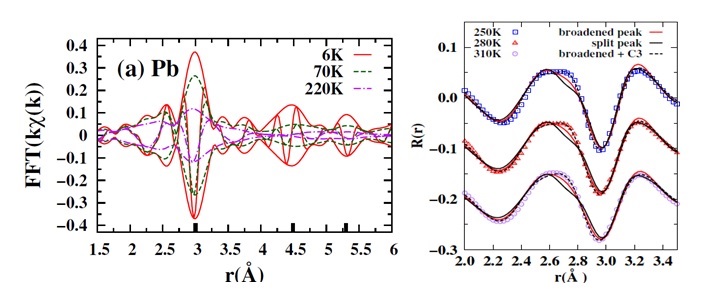When atoms are displaced from the usual lattice site in a crystal, they form electric dipoles making the system paraelectric. If these electric dipoles become aligned parallel to each other at low temperatures, the system becomes ferroelectric – the electrical analogue of a ferromagnet. Although off-center displacements sometimes do occur as the temperature is lowered, they generally do not form upon heating a material. However this unusual characteristic, which would be an important new result, was proposed by Bozin et al. [1] for the important thermoelectric material PbTe, following an analysis of neutron pair distribution function (NPDF) data. They suggested that Pb moves off-center in this simple rock-salt structure as the temperature increases above ~100 K and is displaced by approximately 0.18 Å at 300 K, resulting in the formation of significant Pb-Te dipoles. For such a displacement there will be three Pb-Te bond lengths instead of one, split by ± 0.18 Å. A difficulty for this system is that it is quite soft (weak springs between atoms) and the atomic vibrations have large amplitudes at room temperature. In addition, the vibrations become anharmonic [2,3] at higher temperatures, i.e. the vibration amplitude is not the same for expansion and compression of the Pb-Te bond.
Most scattering experiments, including NPDF analysis, only have amplitude information. Consequently, it is difficult to differentiate between a broadened distribution and a split distribution of bond lengths for splittings on the order of 0.15 Å. In contrast, the extended x-ray absorption fine structure (EXAFS) technique employed in the present study also has phase information that provides a clear distinction between these two possibilities. The effects of a large splitting are clearly visible. In general, when there is significant destructive interference between components in the EXAFS r-space data, the amplitude is decreased and often there are kinks or phase shifts.
To investigate possible off-center displacements, Bridges and co-workers have recently performed EXAFS experiments at the Pb LIII- and Te K edges at SSRL’s Beam Line 4-1. The work, published in the journal Physical Review Letters, shows that Pb is in fact not off-center.

Fig. 1 Plot of the r-space EXAFS data as a function of temperature for the Pb LIII edge, showing strong temperature dependence. The fast oscillating function is the real part of the Fourier transform (FT), R, and carries phase information. The Pb-Te peak is near 3 Å. Right: Fits of the function R to various models at high temperature where Pb is proposed to be off-center. Best fit is for a broadened peak with some asymmetry (dashed line); poorest fit is for the split peak (black line) which has a significant kink near 2.6-2.8 Å.
In Fig. 1 we show the Pb LIII-edge r-space data as a function of temperature. In this plot the different peaks correspond to various shells of neighbors around the Pb atom, with the Pb-Te peak near 3 Å. As the temperature increases and the atoms begin to vibrate, the amplitude decreases, but there is no obvious change in the shape of the oscillatory function R other than the decrease in amplitude. To investigate off-center displacements, we fit R, the real part of the Fourier transform, to a broadened peak, a split peak, or a broadened peak with a small asymmetry, for temperatures from 250 to 310 K (Fig. 1, right).
The broadened peak fit (red line) models the data quite well but misses the data points in a few places. The fit using the 100 off-center displacement model proposed by Bozin et al. [1] (one short bond, one long bond, and four bonds approximately unshifted) is shown as a black line and is much worse. It has a significant kink from 2.6-2.8 Å, and the disagreement between the fits using the split peaks (black line) and fits using a broadened peak (red line) increases as T increases. The broadened peak fit can be improved by adding some asymmetry to the distribution (C3 parameter) on the high-r side of the distribution, consistent with the known anharmonic behavior. This inproved fit passes through all the data points. Similar results were obtained for the Te K-edge data.
In summary, we find no evidence, up to 310 K, of a significant off-center displacement of the Pb or Te atoms from the average crystal structure position. Displacements of the magnitude proposed by Bozin et al. [1] would produce significant changes in the phase of the real (and imaginary parts) of the Fourier transform; for the Pb edge data this displacement would introduce a large kink in R(r) near 2.7 Å. We agree that thermally induced vibrations grow rapidly with temperature and there is significant thermally-induced disorder at 300 K. Thus, this system does not have high-temperature-induced dipoles. However, the pair potential for Pb and Te atoms is asymmetric, leading to the anharmonic behavior observed by Delaire et al. [2] and Jensen et al. [3].
[1] E. S. Bozin, C. D. Malliakas, P. Souvatzis, T. Proffen, N. A. Spaldin, M. G. Kanatzdis, and S. J. Billinge, Science 330, 1660 (2010)
[2] O. Delaire, J. Ma, K. Marty, A. F. May, M. A. McGuire, M. H. Du, D. J. Singh, A. Podlesnyak, G. Ehlers, M. D.Lurnsden, and B. C. Sales, Nat. Mater. 10, 614 (2011).
[3] K. M. Jensen, E. S. Bozin, C. D. Malliakas, M. B. Stone, M. D. Lumsden, M. G. Kanatzidis, S. M. Shapiro, and S. J. Billinge, Phys Rev. B 86, 085313 (2012).
T. Keiber, F. Bridges, B. C. Sales, “Lead is not Off Center in PbTe: The Importance of r-Space Phase Information in Extended X-ray Absorption Fine Structure Spectroscopy”, Phys. Rev. Lett. 111, 095504 (2013), DOI: 10.1103/PhysRevLett.111.095504.




